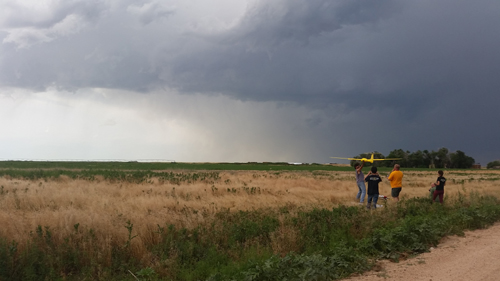My Google Scholar Page Back to Research Homepage
The ongoing, rapid expansion of the use of Unmanned Aircraft Systems (UAS) has created a wide range of opportunities in atmospheric sciences. My resarch in this area provides guidance for operation of fixed-wing UAS in the vicinity of supercells and outflow airmasses, and multi-rotor UAS for profiling of the boundary layer. This guidance will be put into practice in summer 2018 for students at CMU. Check out the opportunities page for more information.
Observations of Supercells Using UAS
UAS have the potential to provide targeted in-situ kinematic and thermodynamic data in supercell environments at varying sub-cloud altitudes. I am currently evaluating the impact UAS datasets could have on improving forecasts of supercells when assimilated into convection allowing models (CAMs). This problem involves the development of an aircraft model that samples data from the simulation as if the aircraft were flying through a simulated supercell with sufficient realism to serve as a proxy for an actual storm. I am currently conducting an Observing System Simulation Experiment (OSSE), where synthetic data sampled from the rear/forward flank gust fronts, and the inflow region of this simulated storm will then be assimilated into relatively coarse simulations meant to represent the typical CAM. UAS deployment strategies will be graded objectively based on how closely their corresponding CAM simulation compares to the evolution of the supercell in the original simulation.
Multi-Rotor UAS Boundary Layer Sampling
Houston and Keeler (2018) considers the impact of airspeed and an instrument’s sensor response time on the dataset one would sample in the field, and how this applies to accurate representation of typical boundary layer phenomena using sUAS. Results from this work provide guidance on recommended ascent or descent rates for profiling of boundary layers, which will tie in to my upcoming fieldwork in coastal meteorology.